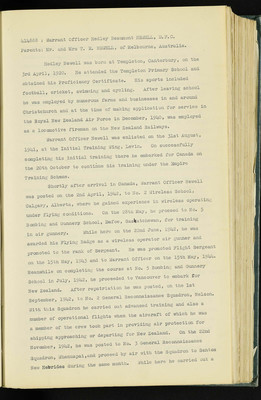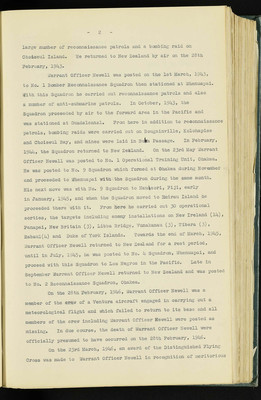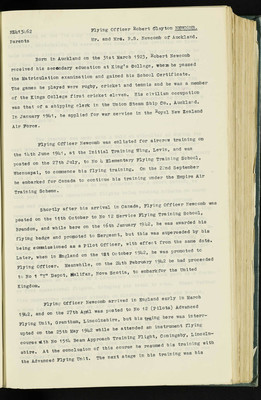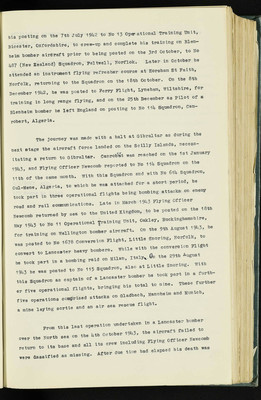Pages That Need Review
RNZAF Biographies of Deceased Personnel: 1939 - 1945, Na - Py
42
414888: Warrant Officer Hedley Beaumont NEWELL, D.F.C. Parents: Mr. and Mrs. T.R. NEWELL, of Melbourne, Australia.
Hedley Newell was born at Templeton, Canterbury, on the 3rd April, 1920. He attended the Templeton Primary School and obtained his Proficiency Certificate. His sports included football, cricket, swimming and cycling. After leaving school he was employed by numerous farms and businesses in and around Christchurch and at the time of making application for service in the Royal New Zealand Air Force in December, 1940, was employed as a locomotive fireman on the New Zealand Railways.
Warrant Officer Newell was enlisted on the 31st August, 1941, at the Initial Training Wing, Levin. On successfully completing his initial training there he embarked for Canada on the 20th October to continue his training under the Empire Training Scheme.
Shortly after arrival in Canada, Warrant Officer Newell was posted on the 2nd April, 1942, to No. 2 Wireless School, Calgary, Alberta, where he gained experience in wireless operating under flying conditions. On the 28th May, he proceed to No. 5 Bombing and Gunnery School, Dafoe, Saskatchewan, for training in air gunnery. While here on the 22nd June, 1942, he was awarded his Flying Badge as a wireless operator air gunner and promoted to the rank of Sergeant. He was promoted to Flight Sergeant on the 15th May, 1943, and to Warrant Officer on the 15th May, 1944.
Meanwhile on completing the course at No. 5 Bombing and Gunnery School in July, 1942, he proceeded to Vancouver to embark for New Zealand. After repatriation he was posted, on the 1st September, 1942, to No. 2 General Reconnaissance Squadron, Nelson. With this Squadron he carried out advanced training and also a number of operational flights when the aircraft of which he was a member of the crew took part in providing air protection for shipping approaching or departing for New Zealand. On the 22nd November, 1942, he was posted to No. 3 General Reconnaissance Squadron, Whenuapai, and proceed by air with the Squadron to Santos New Hebrides during the same month. While here he carried out a
43
- 2 -
large number of reconnaissance patrols and a bombing raid on Cholseul Island. He returned to New Zealand by air on the 28th February, 1943.
Warrant Officer Newell was posted on the 1st March, 1943, to No. 1 Bomber Reconnaissance Squadron then stationed at Whenuapai. With this Squadron he carried out reconnaissance patrols and also a number of anti-submarine patrols. In October, 1943, the Squadron proceeded by air to the forward area in the Pacific and was stationed at Guadalcanal. From here in addition to reconnaissance patrols, bombing raids were carried out on Bougainville, Kolohapise and Choiseul Bay, and mines were laid in Buka Passage. In February, 1944, the Squadron returned to New Zealand. On the 23rd May Warrant Officer Newall was posted to No. 1 Operational Training Unit, Ohakea. He was posted to No. 9 Squadron which formed at Ohakea during November and proceeded to Whenuapai with the Squadron during the same month. His next move was with No. 9 Squadron to Nausori, Fiji, early in January, 1945, and when the Squadron moved to Emirau Island he proceeded there with it. From here he carried out 30 operational sorties, the targets including enemy installations on New Ireland (14), Panapai, New Britain (3), Libba Bridge, Vunakanau (3), Tibera (3), Rabaul (4) and Duke of York Islands. Towards the end of March, 1945, Warrant Officer Newell returned to New Zealand for a rest period, until in July, 1945, he was posted to No. 4 Squadron, Whenuapai, and proceed with this Squadron to Los Negros in the Pacific. Later in September Warrant Officer Newell returned to New Zealand and was posted to No. 2 Reconnaissance Squadron, Ohakea.
On the 28th February, 1946, Warrant Officer Newell was a member of the crew of a Ventura aircraft engaged in carrying out a meteorological flight and which failed to return to its base and all members of the crew including Warrant Officer Newell were posted as missing. In due course, the death of Warrant Officer Newell were officially presumed to have occurred on the 28th February, 1946. On the 23rd March, 1946, an award of the Distinguished Flying Cross was made to Warrant Officer Newell in recognition of meritorious
48
NZ413462 Flying Officer Robert Clayton NEWCOMB. Parents. Mr. and Mrs. R.S. Newcomb of Auckland.
Born in Auckland on the 31st March, 1923, Robert Newcomb received his secondary education at King's College, where he passed the Matriculation examination and gained his School Certificate. The games he played were rugby, cricket and tennis and he was a member of the Kings College first cricket eleven. His civilian occupation was the of a shipping clerk in the Union Steam Ship Co., Auckland. In January 1941, he applied for war services in the Royal New Zealand Air Force.
Flying Officer Newcomb was enlisted for aircrew training on the 14th June 1941, at the Initial Training Wing, Levin, and was posted on the 27th July, to No 4 Elementary Flying Training School, Whenuapai, to commence his flying training. On the 22nd September he embarked for Canada to continue his training under the Empire Air Training Scheme.
Shortly after his arrival in Canada, Flying Officer Newcomb was posted on the 11th October to No 12 Service Flying Training School, Brandon, and while here on the 16th January 1942, he was awarded his flying badge and promoted to Sergeant, but this was superseded by his being commissioned as Pilot Officer, with effect from the same date. Later, when in England on the 1st October 1942, he was promoted to Flying Officer. Meanwhile, on the 24th February 1942 he had proceeded to No 1 "Y" Depot, Halifax, Nova Scotia, to embark for the United Kingdom.
Flying Officer Newcomb arrived in England early in March 1942, and on the 27th April was posted to No 12 (Pilots) Advanced Flying Unit, Grantham, Lincolnshire, but his training here was interr-upted on the 25th May 1942 while he attended an instrument flying course with No 1514 Beam Approach Training Flight, Coningsby, Lincoln-shire. At the conclusion of this course he resumed his training with the Advanced Flying Unit. The next stage in his training was his
49
his posting on the 7th July 1942 to No 13 Operational Training Unit, Bicester, Oxfortshire, to crew-up and complete his training on Blen-heim bomber aircraft prior to being posted on the 3rd October, to No 487 (New Zealand) Squadron, Feltwell, Norflok. Later in October he attended an instrument flying refresher course at Horsham St Faith, Norfolk, returning to the Squadron on the 18th October. On the 8th December 1942, he was posted to Ferry Flihgt, Lyneham, Wiltshire, for training in long range flying, and on the 25th December as Pilot for a Blenheim bomber he left England on posting to No 114 Squadron, Can-robert, Algeria.
The journey was made with a halt at Gibraltar as during the next stage the aircraft force landed on the Scilly Islands, necess-itating a return to Gibraltar. Canrober was reached on the 1st January 1943, and Flying Officer Newcomb reported to No 114 Squadron on the 11th of the same month. With this Squadron and with No 614 Squadron, Oul-Mene, Algeria, to which he was attached for a short period, he took part in three operational flights being bombing attacks on enemy road and rail communications. Late in March 1943 Flying Officer Newcomb returned by sea to the United Kingdom, to be posted on the 18th May 1943 to No 11 Operational Training Unit, Oakley, Buckinghamshire, for training on Wellington bomber aircraft. On the 9th August 1943, he was posted to No 1678 Conversion Flight, Little Snoring, Norfolk, to convert to Lancaster heavy bombers. While with the conversion Flight he took part in a bombing raid on Milan, Italy. On the 29th August 1943 he was posted to No 115 Squadron, also at Little Snoring. With this Squadron as captain of a Lancaster bomber he took part in a furth-er five operational flights, bringing his total to nine. These further five operations comprised attacks on Gladbach, Mannheim and Munich, a mine laying sortie and an air sea rescue flight.
From this last operation undertaken in a Lancaster bomber over the North sea on the 4th October 1943, the aircraft failed to return to its base and all its crew including Flying Officer Newcomb were classified as missing. After due time had elapsed his death was



